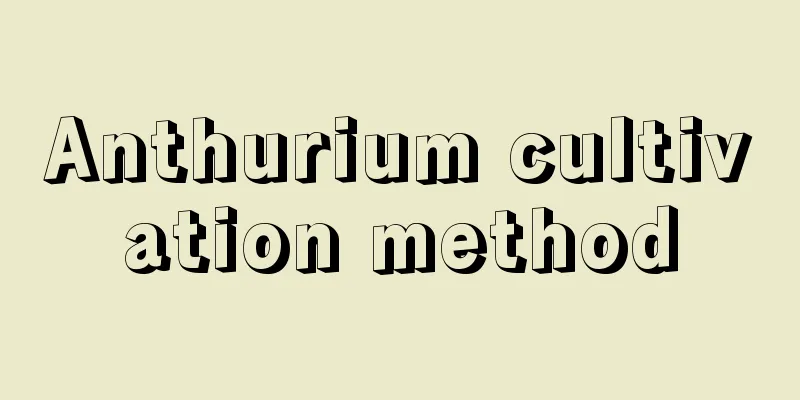Anthurium cultivation method

1. Soil selectionWhen raising it at home, you can buy the prepared culture soil directly from the gardening store. After returning home, add a small amount of expanded clay or dry bark to the nutrient soil we bought. Expanded clay: dry bark = 2:1. However, the soil for planting Anthurium must maintain good permeability and drainage. The soil must be disinfected before planting. However, if you have prepared special soil, you can skip this step. Disinfection is to reduce the chance of anthurium being affected by diseases and pests in the later stages of its growth. 2. Temperature requirementsThe most suitable growth temperature for Anthurium is 14~35℃. In winter, the temperature is below 10℃ and Anthurium is easily frostbitten, so warm it up in time. When the temperature is above 35℃ in summer, sprinkle water around the anthurium to cool it down. 3. How to add fertilizerAnthurium likes fertilizer and has a higher demand for magnesium fertilizer. It is best to go to a professional flower shop to buy foliar fertilizer with high magnesium content for use together. Or you can choose water-soluble compound fertilizer and dilute it into liquid fertilizer to fertilize Anthurium. Spray once a week during the growing season. When applying fertilizer, adhere to the principle of "thin fertilizer and frequent application". It is better to apply less rather than more. Too much will directly burn the seedlings. 4. Watering cycleThe watering of Anthurium needs to be carried out according to the dryness of the potting soil. According to the rules summarized by flower lovers, we should weed once every three days in spring and autumn. Once every two days in summer, and pay attention to use a sprayer to spray the leaves at noon to increase humidity. In winter, water once every 5 to 7 days. When the weather is cold, water between 9 am and 4 pm. When watering, pay attention to alternating between dry and wet, and avoid watering in severe water shortage conditions, which will affect the growth and development of Anthurium. 5. Pay attention to humidity controlHigh temperature and high humidity are the environments that Anthurium likes. Humidity is related to temperature. If the room temperature is higher than 28°C, we need to manually increase the indoor humidity. You can use a humidifier or sprinkle water to humidify. When the temperature is below 20℃, just maintain the indoor humidity without watering. In winter, even if the indoor temperature is high, it is best not to cool down or moisturize too much. If the leaves of the plant are too wet at night, it will reduce its ability to resist cold and cause frostbite, which is not conducive to wintering. 6. Prevention and control of diseases and insect pestsThe most common pests of Anthurium are red spider mites, nematodes, cabbage worms, whiteflies, thrips, snails, and scale insects, among which red spider mites, nematodes, and cabbage worms are the most common. However, anthurium is very sensitive to pesticides. If you can only use pesticides, it is best to choose low concentrations. One thing that needs special attention is that any pesticides containing copper, such as dimethoate, dichlorvos, malathion, parathion, methyl parathion, etc., will be toxic to anthurium and it is best not to use them. 7. How to pruneIn order to prevent Anthurium from excessive consumption, we should cut off the dead branches and twigs in time during the growth period of Anthurium. The pruning technique of Anthurium is "three adjustments and two cuts", which means adjusting the direction, adjusting the plant, cutting the suckers, cutting the flower buds, and cutting the old flowers. |
<<: How to grow daisies in pots
>>: The difference between the advantages and disadvantages of honeysuckle
Recommend
Can roses survive without soil when transplanted? (Can roses be transplanted without roots?)
Can the old roots of roses be planted without soi...
Can I use ordinary soil for my green radish?
1. Yes The vitality of the green ivy is very stro...
Cultivation methods and precautions of Schefflera
1. Breeding environment 1. Soil: You can use peat...
Cutting propagation method of field grass
time Cutting propagation of Achyranthes bidentata...
Is it better to use diammonium fertilizer or compound fertilizer to grow corn (what compound fertilizer is better to grow corn)
Is it better to use diammonium phosphate or compo...
Do daisies prefer shade or sun?
Do daisies prefer shade or sun? Daisies are easy ...
Cultivation methods and precautions of agapanthus
1. Soil requirements When growing Agapanthus, the...
How to save the white hosta leaves from turning yellow
1. Change the soil White hosta requires well-drai...
How to fertilize poinsettia? Doing so will make the flowers super colorful!
Growth habit Poinsettia needs to grow in an envir...
Is the fortune tree poisonous? Can it be placed in the bedroom?
1. Is it toxic? The money tree is not poisonous a...
The efficacy and function of mulberry
1. Aid digestion Mulberry seeds are rich in fatty...
How to cultivate Cypripedium
1. Soil For breeding, soil with good air permeabi...
How to prune old wintersweet and when to prune it
1. Pruning method When pruning old stumps, the ma...
How long does it take to pot a succulent plant after root pruning (after pruning the roots in spring, let them air dry for a few hours before potting)
When repotting succulents in spring, it is essent...
Tips on how to deal with yellowing leaves
Many people will encounter various problems when ...









